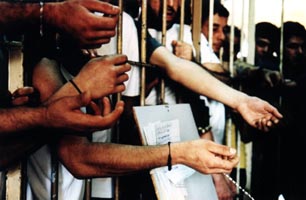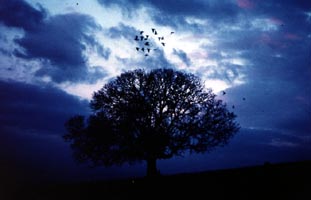|
To
spiti tou Cain
|
Christos
Karakepelis
|
|
Im Hause Kains |
Griechenland
2000
|
 |
 |
| Delphi-Filmpalast 11.02 13.30 CinemaxX 3 12.02 18.15 CineStar 8 12.02 14.00 Kino Arsenal 09.02 11.45 |
| Produktion/Weltvertrieb: Greek Film
Centre 10 Panepistimiou Ave., 10671 Athen Tel.: (30-1) 3634 586, Fax: 3614 336 Buch: Natasha Segou, Christos Karakepelis Kamera: Yannis Valeras Ausstattung: Michalis Samiotis Musik: Thanos Mikroutsikos Ton: Panos Papademetriou, Stephanos Efthemiou, Dinos Kittou Schnitt: Giorgos Triantafyllou Format: 35mm, Farbe Länge: 80 Minuten, 24 Bilder/Sek. Sprache: Griechisch |
| Das Thema ist Mord. Die Protagonisten sind sieben Männer
und Frauen, die zu Mördern wurden. Der Film ist der Versuch,
in die Bilderwelt dieser Menschen vorzudringen, in ihre Erinnerungen,
Alpträume, ihre Realität und ihre Bemühungen, aus der
Grenzsituation, in der sie sich befinden, zu entfliehen. Jeder von
ihnen – sechs Gefängnisinsassen, ihr Wächter und ein
Ex-Sträfling – sieht auf seine Weise die unwiderrufliche
Tat, die sein Leben zerstört hat. Das Gefängnis, das Leichenschauhaus,
das Museum für Gegenstände aus Straftaten, die Gerichtssäle,
die Polizei, die Ruinen einer alten Strafkolonie, zu bauende Gefängniszellen
– sie alle tragen Spuren dieser Menschen. Die Straftat selbst
bleibt ausgespart. Im Hause Kains ist eine Reise in den menschlichen
Untergang, in die Schuldgefühle, die jeder in unterschiedlichem
Ausmaß erlebt. „Ich habe mich bewußt für ein ruhiges Tempo meines Films entschieden, um die Akzeptanz der Charaktere zu erleichtern. Dies steht im Kontrast zum gewalttätigen Tempo der Bilder von Fernsehnachrichten. Der langsame Rhythmus macht es außerdem notwendig, gründlicher zu sondieren, jenseits der Vergänglichkeit des Ereignisses nachzuforschen. Er verweist auf einen Zustand der menschlichen Seele.“ Christos Karakepelis |
The film’s subject is murder; its characters are
seven men and women who committed such an act. It plunges into the
people’s images, memories, nightmares, and reality, as well as
their attempts to escape from the borderline situation in which they
live. In his own way, each one of the characters – six prison
inmates, their guard and one former prisoner – encircle the irrevocable
act which embodies the absurd and crushes their existence. The prison,
the morgue, the museum of criminal exhibits, the courts, the police,
the ruins of an old penal colony, prison cells yet to be built –
they all constitute the mourning, and bear the traces of the characters
of the film. The events, the intimate details are absent. The House of Cain is a journey in human decline and the guilt which each person experiences, in whatever way and to whatever extent he can. The film is a silent lament, humble and awkward, for a lost innocence. Whether that can be regained is open to question. It is an exploration of man’s limits, as well as of the boundaries of the documentary format, using the acrobatics of the characters and acrobatics of style. It is the reality of the soul and the senses as the only cinematic reality and record. “I chose film as the only instrument for approaching the subject. I opted for a slow pace to facilitate the calm acceptance of the characters’ presence and to create a hospitable environment for them. In contrast to the boisterous, violent pace of images on television news, this slow pace expresses a need to probe deeper, beyond the ephemeral, beyond the event. It denotes a state of the human soul.“ Christos Karakepelis |
| Christos Karakepelis, geb. 1962 in Serres, Griechenland. Studium der Soziologie und später der Filmregie. Zwei Kurzfilme und zahlreiche Werbefilme, Drehbücher für Dokumentarfilme und Fernsehserien. To spiti tou Cain ist sein erster abendfüllender Film. |